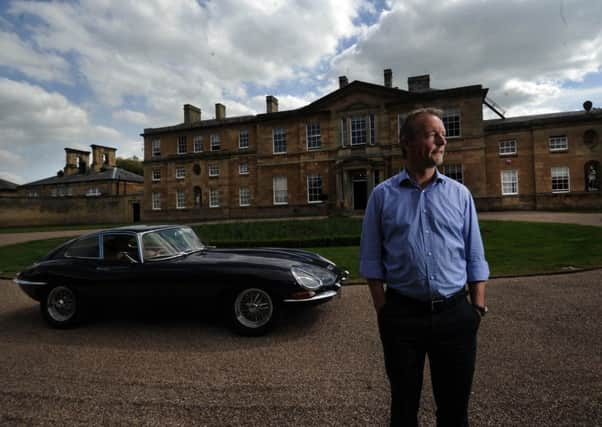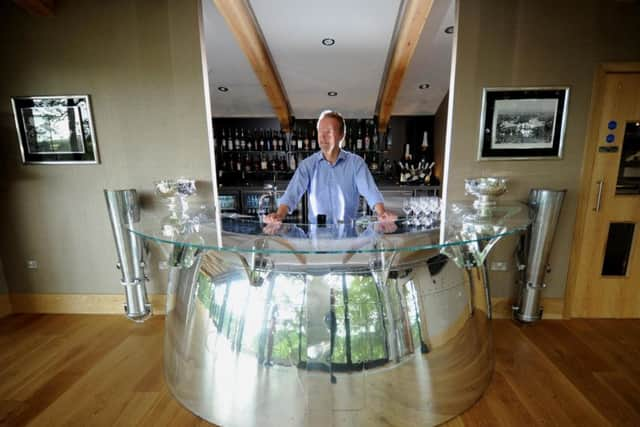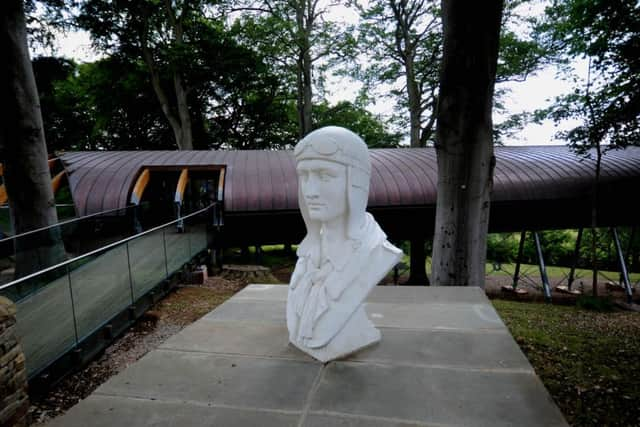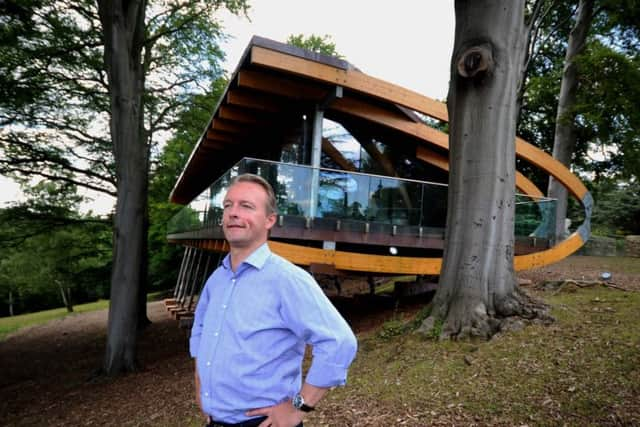Wow with know-how: How to make money - and enjoy it


Enthusiasm and a certain restlessness spring from every pore. Conversation canters over the history of the family business he bought out (from 14 relatives) in 2004, the story of the building we’re sitting in – Bowcliffe Hall at Bramham, near Leeds, the HQ of his Bayford Group – and other hand-picked businesses that rent space in the mansion and adjacent buildings, such as a beautifully restored cricket pavilion.
Before long we’ve moved to a pot of tea and carrot cake in what used to be a white, utilitarian, Ikea-furnished “staff canteen”. What the teams (and club members selected by Turner or groups wishing to hire the rooms) get to enjoy these days is what you can only call true glamour.
Advertisement
Hide AdAdvertisement
Hide AdHe watches my face as we enter – how can I put this? – a fantasy man cave of motoring memorabilia set amid bespoke decor installed with the highest level of craftsmanship. I am no motoring enthusiast, but my eyes pop at the imagination, effort and sheer love that have gone into the execution of this by a man who works hard, knows how to play hard – and wants very much to share his private pleasure in exquisite old cars.


“I want people to say ‘Wow!’ 27 times before they leave,” says Turner. His glee is understandable. The walls are beautifully walnut panelled, in the style of a traditional gentlemen’s club. Glass cabinets house Turner’s trophies from the many races and rallies he’s won in his own vintage cars. He says he can’t remember how many he owns, but they include the first 3L Bentley to race at Le Mans, and a gorgeous blue D Type Jaguar, in which he raced the Orient Express across Europe (and won) in 2012. His calendar is littered with race and rally dates.
The rich dark brown leather banquettes are modelled on the back seat of a Mk 7 Jaguar, complete with pull-down armrests that reveal a box for wine bottles. Each table has a central pedestal made to look like the radiator grille of a particular manufacturer.
We sit at the Austin table, listening to jazz through speakers disguised by handmade radiator panels, and drinking tea from silver pots bought from a pal in Portobello Road, who also supplied thousands of items of cutlery for the elegant Bowcliffe dining room. He even found fine china with a spoke pattern around the edge. Naturally.
Advertisement
Hide AdAdvertisement
Hide AdAt the windows, bespoke Simon Paul art deco style blinds show fabulous women in hats going to a race. Above the doorway from bar/restaurant to soft seating area is a large silver jaguar. Echoes of classic car accoutrements are everywhere, from the light fittings to the door handles.


“I spotted the jaguar from a taxi in the King’s Road, and leapt out because I just had to have it,” says Turner. A hole was knocked in the wall to accommodate the feline being suspended, “leaping” from one room to the next. He owns one of the UK’s most important collections of motoring art, and these two rooms, the Bowcliffe Drivers’ Club, as well as adjacent corridors, are lined with amazing action paintings and drawings of car racing dating back to the 1920s.
Bryan de Grineau’s Le Mans 1929 and Brooklands 1930 and equally enthralling scenes by Gordon Crosby and Gordon Horner capture the mud-spattered drama and romanticism of the early motor racing circuits. In amongst them are portraits of the “Bentley Boys”, and the odd photo of Turner and friends taking part in rallies and races.
One of his craziest exploits was the 11,000-mile, six-week Peking to Paris rally in 2007, in which he and friend Adam Hartley drove a 1907 Itala. It had wooden wheels, no windscreen and no doors – so the two men had to rope themselves together in case one fell out on a bend.
Advertisement
Hide AdAdvertisement
Hide Ad“We broke down as we crossed the Gobi Desert, but managed to get a truck to take us to a place in Siberia where the engine was replaced by one from a 100-year-old Volga. At another point a wheel fell off and we had to repair it using roofing nails. Because of the terrible heat, we wrapped wet towels around the wheels at night so they didn’t dry out and break.”


Turner isn’t at all interested in the hi-tech world of Formula 1. He’s clearly a romantic, to the extent that, after she had successfully navigated for him in the 1998 Monte Carlo Rally, he proposed to his Norwegian girlfriend Karen. They now have three children and live in a farmhouse near Ripon.
Born and brought up in Horsforth, Leeds, the 49-year-old was sent off to Oundle, a public school near Peterborough then studied business in Newcastle. He has only a trace of northern in his accent but has a voice that’s charged with energy, and there’s something of the dashing country squire about him.
While the Bayford Group (originally coal merchants, today major interests still include energy, but also forestry and property in all worth £400m a year) is steered in a day-to-day sense by his “brilliant” managing director Liz Slater, Turner says his thing is “big, imaginative ideas”.
Advertisement
Hide AdAdvertisement
Hide AdHe’s not done badly, for a man whose father once told him: “You’ll never do as well as me”.
Four years ago, his big, imaginative idea was to build a tree house, looking out across Bowcliffe’s lush 50 acres of Yorkshire that adjoin the Bramham Park Estate.
With the help of architects at The Harris Partnership from Wakefield plus top notch builders, engineers and other craftspeople (again 85 per cent of materials sourced in Yorkshire, including the glass – an accomplishment Turner refers to as ‘the Yorkshire Pound”) the tree house scheme pretty quickly morphed into something much more ambitious and startling.
Spending more than £1m of the £6.5m so far lavished on the refurbishment of the hall and 50-acre estate, across the lawn is a startling and unique cantilevered building that rises 10 metres from the sloping ground at one side. The basic structure relies on the curve of glulam beams – bent and layered timber, made in Hull – which are covered in gleaming copper. It’s like no tree house I’ve ever seen.
Advertisement
Hide AdAdvertisement
Hide AdIts oval structure with wraparound timber and glass deck is 40m long, the shape is based on the wing of an aircraft in a bygone age realised in gleaming, beautiful modernity. Its purpose is meetings and other gatherings – Credit Suisse hired it the other day for a function where Sir John Major was a special guest. With capacity for 150 people, its potential for a party is exciting.
What turned a boy’s own hideaway into this staggering, multi-award-winning building was a link with Bowcliffe Hall’s past. The long-time owner of the 1815 hall until his death in 1955 was Robert Blackburn, the Leeds-born and Leeds University educated aviation pioneer. The 15-bedroom pile was his home.
Turner began to study Blackburn’s life, and another obsession was born. “I felt he was too little known, yet he has a really important place in history. He seemed to have fallen off the map, and I wanted to do my little bit to put that right and draw attention to him.”
The Blackburn Wing is scattered with framed photos of aviation luminaries like Amy Johnson and Blackburn Aviation planes. Blackburn built his first monoplane in 1909 and flew it at Saltburn in 1910. Three years later, after marrying an heiress, he expanded his business to become the Blackburn Aerospace and Motor Company, based in Roundhay Road, Leeds.
Advertisement
Hide AdAdvertisement
Hide AdDemonstration flights took off from Roundhay Park, and he introduced the first scheduled flights in the UK, with a regular half-hour passenger service between Leeds and Bradford and then Leeds and Hounslow, near London. In 1916 Blackburn opened a new factory at Brough in East Yorkshire. Blackburn’s business later became swallowed up by Hawker Siddeley and then British Aerospace, and his name was dropped from the credits.
Focusing on microscopic detail, Turner set about creating his vision of an aviation- themed building to the nth degree of perfectionism in Blackburn’s honour. Finding a source in the US, the glass-topped semi-circular bar is one half of a jet engine, polished to silvery perfection. A burnished aircraft wing tip is horizontally placed atop legs and layered beneath glass to make a startling conference table. The leather chairs are clad in studded aluminium.
All the rounded door handles are custom-built copies of propeller nose cones. From the taps and lighting in the loos to the “runway” lights lining the walkway outside, Turner and his talented team found a way of echoing many aspects of early aircraft design and technology and marrying it with modern, slightly spacey aesthetic.
“The wing came into being because I felt Blackburn had been undeservedly forgotten. As with the Drivers’ Club, I really wanted the ‘wow factor’.
Advertisement
Hide AdAdvertisement
Hide Ad“Above all I’m a very proud Yorkshireman, and I wanted to honour a fantastic fellow Yorkshireman.”
Obligingly – but also because his imagination and flair genuinely deserve it – I have said “Wow!” at least 27 times before I leave.
• http://bowcliffehall.co.uk